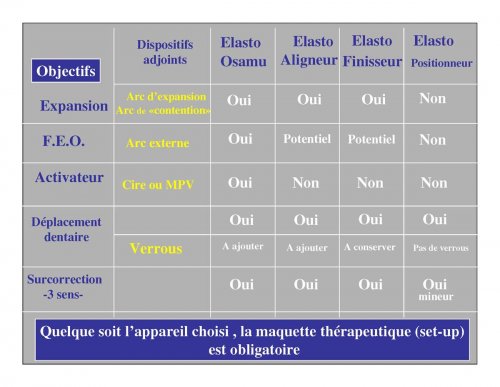C’est grâce à ces progrès dans le domaine de la plasturgie que Carl GUGINO et Osamu YOSHII ont pensé utiliser les propriétés élastiques d’un matériau pour construire des appareils souples en élastomère injecté : polyvinyle silicone.
Ce matériau possède en outre trois degrés de dureté compatibles et juxtaposables. C’est le concept d’élastopositionnement.
L’appareil est constitué d’une gouttière bimaxillaire dont la construction est effectuée à partir d’une maquette thérapeutique qui intègre les objectifs de traitement orthopédique et/ou orthodontique, réfléchis et définis par le praticien pour le patient concerné.
La construction de cette maquette est obligatoirement faite à partir de moulages montés sur articulateur S.A.M. pour intégrer les référentiels occlusaux du patient.
Les possibilités du matériau, alliées à la réflexion individualisée et à la précision de la maquette thérapeutique permettent la fabrication d’appareils souples.
De plus, les trois degrés de dureté possibles de matériau permettent de faire varier les possibilités élastiques dans les zones choisies, plus ferme ou plus souple selon les objectifs définis.
There are several types of elastopositioning devices (4), depending on the treatment objectives envisaged:
1. L’ÉLASTO OSAMU : allie la capacité thérapeutique de pouvoir effectuer une avancée
mandibulaire (comparable à celle d’un activateur rigide), à la possibilité éventuelle de légers déplacements dentaires.
Au même titre que les activateurs rigides, l’activateur souple Élasto Osamu peut recevoir des auxiliaires type AEO, et/ou un arc interne pour une meilleure coordination transversale.
Sa construction nécessite évidemment la mesure de l’amplitude de la propulsion mandibulaire et est réalisée sur MPV (variateur de position mandibulaire) qui permet de quantifier la descente des condyles mandibulaires.
Les indications de l’Élasto-Osamu sont réservées à des décalages squelettiques de faible amplitude, associés à de légers problèmes de malocclusion. Il est possible de traiter des décalages plus importants, à condition d’utiliser plusieurs appareils successifs, tous programmés individuellement pour le patient concerné.
Il est important de préciser que si le concept de traitement change grâce à
ces nouveaux matériaux, le principe de fonctionnement des activateurs reste identique et ne doit en aucun cas être négligé.
2. L’ÉLASTO ALIGNEUR : des verrous sont apposés sur les dents nécessitant un déplacement.
L’appareil construit à partir de la maquette thérapeutique se clippe sur ces verrous et incite la dent à venir dans l’occlusion requise.
3. L’ÉLASTO FINISSEUR : c’est là où le concept d’élastopositionnement prend sa pleine mesure : l’appareil, constitué par une gouttière bimaxillaire est construit à partir d’une maquette thérapeutique qui intègre les données occlusales de finitions requises pour le patient concerné.
Ces données occlusales ont été réfléchies et ordonnées par le praticien à partir du montage sur articulateur des modèles du patient en phase de finitions orthodontiques.
This is occlusal individualization.
L’action unitaire « dent » par « dent » (l’appareil étant clippé sur les verrous) permet à l’occlusion de se caler parfaitement en respectant les notions de centrage et de guidage (ref. Orthlieb) .
This revolutionary approach to occlusal finishing enables faster debugging, with the gradual development of an individualized functional occlusion.
This concept is particularly valuable in the post-surgical phase, where occlusal finishing must be fast and precise to ensure perfect stability of the ortho-surgical results.
4. L’ÉLASTOPOSITIONNEUR : c’est un positionneur souple et totalement individualisé construit selon le même concept (maquette partielle ou totale).
